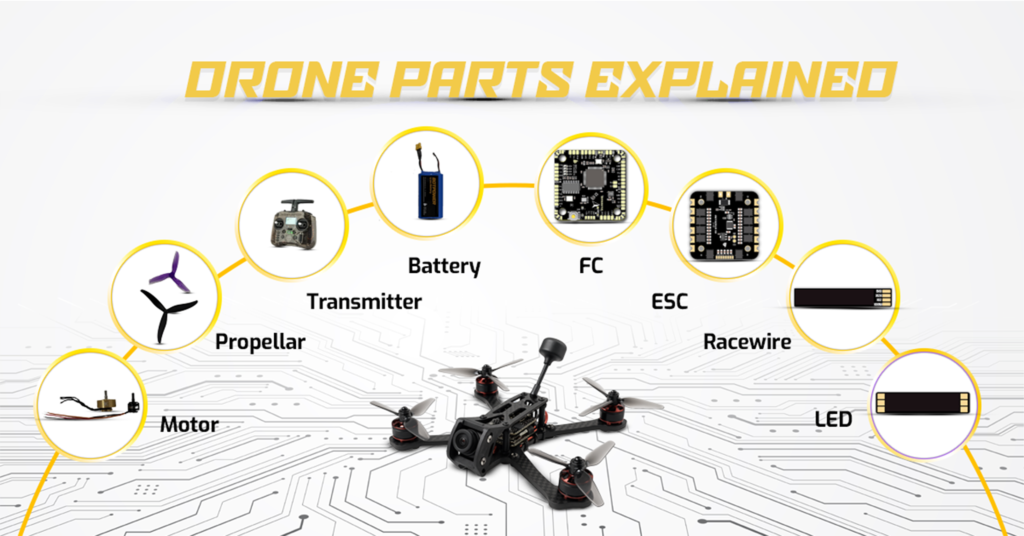To make it very clear, if anyone wants to achieve better performance, new features, and easy maintenance, they must understand what a drone is made of. When you know how each part functions, you can not only fix troubles more quickly but also make the buyers’ choices wisely when you upgrade your drone.
This is a comprehensive guide to the various drone components and their functions. It details the things are these parts are, how they operate in one unit, and even gives examples of the products that you can use. Such a guide is not only useful for a beginner but also for an experienced pilot during the drone building, upgrading or maintaining process.
The Anatomy of a Drone
For the drone to fly correctly, these are the primary parts that must be combined:
- Flight Controllers (FCs): The flight controllers operate the FC, the drone’s brain, which functions similarly to the central command centre. It converts sensor input data, the commands the drone receives, into precise motor control movements and is in charge of the drone’s stability.
- Electronic Speed Controllers (ESCs): In the case of a quadcopter, at least four motors are necessary, as each one is the part that makes a propeller turn. A brushless motor is the most potent, effective, and efficient kind of motor that can be utilised.
- Motors: Since each motor turns a propeller, a quadcopter needs at least four of them. A brushless motor is the most potent, effective, and efficient kind of motor to use.
- Propellers: Propellers also exist in different sizes and materials and have a direct influence on the flight performance of the drone. Choose propellers that are complemented by your motor power to have a smooth and balanced flight.
- Frame: It is the structure which makes sure that the different modules are integrated physically and electrically into the drone.
- Power System & Batteries: The power system is the source of energy for the drone.
- Sensors & Navigation Modules: Besides getting data from sensors, they can also stable flight by avoiding obstacles and holding altitude.
- Radio & Telemetry Modules: These enable the drone and the pilot to communicate with each other, thus allowing sending instructions and receiving information about the drone’s status.
- LEDs and Ancillary Components: In addition to the LED lights for aviation safety, the drones may also be equipped with an ultrasonic microphone, a gyroscope for detecting vibration, etc.
Near-simultaneous operation programs these parts to carry out a command given by the pilot through the flight controller in turn made the ESCs change the rotor speed. The motors spin the propellers, thus creating lift. Sensors give data all the time in order to keep the UAV stable, while the transmission devices convey telemetry to the pilot.
Different drones are designed for different purposes: racing drones are usually very small and can move quickly, photography drones are stable and can carry a camera, and lab or DIY drones provide users with flexibility to do whatever they want.
Flight Controller and Stack Systems
The flight controller is the mind of your drone. It stabilises your drone by converting your commands, received in the form of data by sensors, into motor controls. To ensure a seamless flight experience, get an FC with features like GPS, altitude hold, and programmable functions. It also handles different flight modes, supporting features such as automatic return and holding altitude.
Some features about flight controllers:
- Solderless versus soldered: Quite solderless FCs are quite user-friendly and effortless to set up. Soldered FCs have stronger connections and are, therefore, used in professional or racing drones.
- Stack configurations: Certain FCs are combined with the ESCs in one unit. Consequently, there is less wiring needed, and the volume occupied is reduced. Example: The BotWing F722 series integrates a high-performance FC with ESCs freely accessible for space and weight considerations.
The BotWing F405 or F722 series is one of the most chosen stacks for both beginners and advanced pilots. It not only allows easy integration but also provides reliable performance.
Electronic Speed Controllers (ESCs)
ESCs determine motor speed and ensure a smooth flight per the flight controller’s instructions. For the effectiveness and security of a drone, picking the right ESC is crucial.
Things that one must be aware of regarding ESCs are:
- 4-in-1 ESC or single ESCs: A 4-in-1 ESC will make the drone fit in a more compact way, and it will be easier to wire it up, while with individual ESCs, one can easily replace a part if it breaks down.
- Current rating and firmware: Be sure the ESC you have in mind to get can handle the capacity of your motor and battery. Different firmware options, including BLHeli and DShot, are responsible for the responsive nature of the ESCs, as well as how well the drone will control and react.
- Match motors with batteries: In order to avoid running motors too hot and ensure they work well together, good matching of motors to batteries is incredibly important. Select motors and batteries that are compatible with one another.
Motors and Propulsion
The standard type of brushless motor is the one that is mostly used on the drones; these are selected precisely because they are energy-efficient, have a longer lifespan, and are very accurate. The power generated by these motors to revolve the propellers is the same power that comes from electromagnetic attractions or repulsions without friction from brushes.
Points for motor and propeller selection:
- Motor parameters: The weight of the motor will impact how easy the drone is to carry, the stator size will impact how much torque the motor will generate, and the “KV” rating will dictate how fast the motor will run.
- Propellers: The drone specs will determine the proper size and pitch of the propeller, as well as how many blades. Photographic drones will have larger, slower propellers for stability, whereas a racing drone may have smaller, faster propellers in order to make it more agile.
Balancing and vibration: A properly balanced propeller will not have any vibration; this increases the stability of the drone and increases the working life of its parts.
Frame and Airframe Components
The frame of the drone is its skeleton; it not only integrates the different parts of the drone but also has a great influence on the flight performance of the drone. Typical designs for frames are X, H, stretch, and cine frames. Carbon fibre frames are both lightweight and strong, whereas frames made of composites are more affordable but a bit less stiff.
Other considerations:
- Mounting points for the electronics and batteries
- Weight and rigidity
- Vibration damping using grommets or isolators that protect sensitive electronics from vibration
Power System and Batteries
Drones are powered by LiPo or LiHV batteries. The voltage of the battery is determined by its cell count, capacity is related to the flight time, and the C-rating is the indicator of the maximum discharge rate.
Power setup tips:
- Power Distribution Boards (PDB) allow you to wire your setup in a neat and convenient way. If you have a lighter build, you can go for direct wiring.
- Choose connectors such as XT60 or XT30 that have the appropriate wire gauge and will match your setting.
- Battery safety should be the priority; hence, always balance the charge of your batteries and do not allow them to be over-discharged. Proper battery management will result in a safer battery with a longer life span.
Sensors and Navigation Modules
Sensors in the drone help it to be steady as well as to navigate correctly. The standard sensor package consists of gyroscopes, accelerometers, barometers, and magnetometers. Positioning, holding, and return-to-home functions are given by GPS or GNSS modules.
Moreover, these sensors, such as optical flow or LiDA, can make indoor navigation and accurate positioning better. A perfect instance of this situation is the BotNavigator GNSS V1, which allows satellite-based positioning that is not only safe for beginners but also reliable for advanced users.
Radio, Telemetry, and Link Modules
Communication between the pilot and the drone is one of the main features. Receivers and transmitters make use of protocols like ELRS, PWM, or SBUS. Telemetry modules collect various flight data and transmit it to the pilot, such as battery level and altitude.
Different Antenna setups, such as dipole, patch, or diversity, are some features that help in getting better range and more trustworthy links. The BotLink 2.4GHz ELRS V1 is a good example of a communication module that is low-latency and can be relied on for FPV and racing drones.
LEDs, Wiring, and Ancillary Components
LEDs give the pilot an indication of the orientation of the drone and also make the drone visible during the flight. Safe and durable products are the result of the proper wiring and connectors, such as silicone wires and race wires. The elements that are being installed on the drone for its protection and for the vibrational reduction are small in size, and they could be made of grommets, dampers, capacitors, and fuses.
Firmware, Software, and Configuration
Firmware for drones, such as Betaflight, INAV, or ArduPilot, is capable of providing features of advanced flight features. The process of tuning can be done in parameters like PID, flight rates, and filters that will result in better performance. The use of GUI and CLI makes the setup easier, while on-screen displays (OSD) give updates during the flight.
By the way, a configuration upgrade is a must before firmware updates so that presets will not be lost.
Component Matching and Compatibility
Compatible components are essential for seamless performance. Take into account the total current draw, weight, and upgrade potential. When the parts that match are correctly matched in the right way will not only reduce the risk of overheating to some extent, but it will also increase the stability of the flight and make future upgrades easier.
Troubleshooting and Maintenance
The list of common problems which many users will face in their ESC-motor is Electronic Speed Controller (ESC) failure, motor issues, wires getting loose and sensor errors. Regularly inspecting solder joints, connections, and wiring. If there is a need, a firmware reset or update should be done, and preventive maintenance should be performed, such as motor cleaning, screw tightening and battery health checking.
Buying Advice and What We Offer
In the first place, the parts, specifications, reviews, and warranties are used to ensure quality. BotLab Dynamics provides premium-grade components, experienced customer care, and a vast array of products, both for beginner and professional use. The starter kits and bundles make it effortless to create drones without the need to suppose which parts are compatible with each other.
Conclusion
The learnings that go into the pilot’s mind are when he/she comprehends the six basic building blocks of the drone: flight controller, ESCs, motors, frame, sensors, and power system. Through safe experimenting, learning, and upgrading of your drone, you will eventually become a better pilot. Turn to BotLab Store for parts that you can depend on and guidance for your next venture.
FAQs
Q: What is the difference between FC and ESC?
The flight controller unit (FC) is the brain of the drone, taking care of the stabilisation besides all other functions. An ESC, in simple terms, is like a car accelerator. In response to commands from the FC, it modifies the motor speed.
Q: Is it possible to combine motor and ESC brands?
Yes, you can; just make sure that the connectors, firmware, and current rating are all compatible.
Q: How frequently should sensors be calibrated?
Only after sensor firmware has been updated, during new builds, or in the event that the drone displays unusual behaviour should calibration be carried out.
Q: Is a GPS always required?
While autonomous flight, position hold, and return-to-home capabilities require GPS, racing and indoor drones do not require it.








Leave a Reply